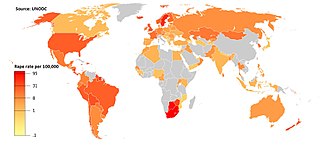Research
| External videos | |
|---|---|
| The 2013 Women's History Month Keynote Address at Emory University,28 March 2013 | |
Lisak began his research in graduate school at Duke in the 1980s. He had noticed that most of the research on rape and sexual assault consisted of interviews with victims,who reported almost exclusively acquaintance rape rather than stranger rape,and studies on incarcerated rapists,who were almost exclusively stranger rapists. Lisak became interested in studying the rapists who committed the most common form of rape but who did not get caught and go to prison. [4]
Lisak performed a meta-analysis of four surveys conducted from 1991 to 1998,surveying 1,882 male Boston college students,resulting in a landmark study of undetected rapists that was published in 2002. [5] The study began with a questionnaire,which Lisak reported following up with interviews of each respondent. [4] The questions included things like "Have you ever had sexual intercourse with someone,even though they did not want to,because they were too intoxicated [on alcohol or drugs] to resist your sexual advances?" and "Have you ever had sexual intercourse with an adult when they didn't want to because you used physical force [twisting their arm,holding them down,etc.] if they didn't cooperate?" [6] In 2015,Linda M. LeFauve,an Associate Vice President at Davidson College and contributor to the American libertarian think tank Reason Foundation,questioned Lisak about how he conducted follow-up interviews based on responses to an anonymous survey;Lisak refused to comment and hung up the phone. [5]
As with other social science interviews and questionnaires about interpersonal violence,Lisak avoided the use of terms such as "rape","assault",and "abuse",instead describing in detail the behavior in question,without applying labels that the perpetrators might not identify with. [4] Although the situations described are legally rape,Lisak found the men were not reluctant to talk about them,seeing them as sexual conquests to brag about,and did not think of themselves as rapists;according to Lisak,such men are narcissistic and "like nothing better" than to talk about their "sexual exploits". [7] Approximately 5% of the study participants reported having committed rape. [8]
Lisak notes that most rapists who are prosecuted are convicted on a single count of rape,and describes as sobering studies that find incarcerated rapists typically have raped multiple people,with findings ranging from an average of seven to an average of 11 victims. [8] His own research found the same was true for undetected rapists,with serial rapists accounting for 90% of all campus rapes [8] with an average of six rapes each. [9] [10] He found that both undetected and convicted rapists held prejudiced attitudes towards women and a need for dominance. [4]
Compared with non-rapists,Lisak found that rapists are measurably more angry at women and more motivated by a desire to dominate and control them,are more impulsive,disinhibited,anti-social and hyper-masculine,and less empathic. Lisak characterized rapists as extremely adept at identifying potential victims and testing their boundaries,and said that they planned their attacks and used sophisticated strategies to isolate and groom victims,used violence instrumentally in order to terrify and coerce,and used psychological weapons against their victims including power,manipulation,control and threats. [8] Lisak also says that rapists target vulnerable victims,such as female freshmen who have less experience with drinking and are more likely to take risks,or people who are already intoxicated;they use alcohol as a weapon, [7] [8] as it makes the victim more vulnerable at the time but also impairs their credibility with the justice system should they choose to report the rape. [11]
Lisak has also noted that recent research has contradicted the long-held assumption that rapists specialize in particular types of victims with the reality,he says,being "far murkier". "Multiple studies," he has written,"have now documented that between 33% and 66% of rapists have also sexually attacked children;that up to 82% of child molesters have also sexually attacked adults;and that between 50% and 66% of incest offenders have also sexually attacked children outside their families." [8]
Lisak argues that his and similar findings conflict sharply with the widely held view that college rapes are typically perpetrated by "a basically 'decent' young man who,were it not for too much alcohol and too little communication,would never do such a thing",with the evidence actually suggesting that the vast majority of rapes are committed by serial,violent predators. Therefore,he argues,prevention efforts aimed at persuading men not to rape are unlikely to work,and universities should instead focus on helping non-rapists to identify rapists and intervene in high-risk situations to stop them. [8] He also argues that whenever a nonstranger sexual assault is reported,it represents a window of opportunity for law enforcement to comprehensively investigate the alleged offender,rather than "putting blinders on looking solely on the alleged 45-minute interaction between these two people". [4] [12]



